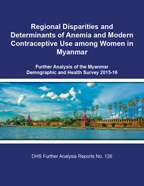- PUBLICATIONS
- JOURNAL ARTICLES
- ACCESS PUBLICATIONS
Publications Summary
- Document Type
- Further Analysis
- Publication Topic(s)
- Anemia, Family Planning, Geographic Information, Nutrition
- Country(s)
- Myanmar
- Survey
- Myanmar DHS, 2015-16
- Language
- English
- Recommended Citation
- Ko Ko, Min, Hla Hla Win, and Kerry L. D. MacQuarrie. 2019. Regional Disparities and Determinants of Anemia and Modern Contraceptive Use among Women in Myanmar. Further Analysis of the Myanmar Demographic and Health Survey 2015-16. DHS Further Analysis Reports No. 126. Rockville, Maryland, USA: ICF.
- Download Citation
- RIS format / Text format / Endnote format
- Publication Date
- June 2019
- Publication ID
- FA126
Download
 Regional Disparities and Determinants of Anemia and Modern Contraceptive Use among Women in Myanmar (PDF, 718K)
Regional Disparities and Determinants of Anemia and Modern Contraceptive Use among Women in Myanmar (PDF, 718K)
